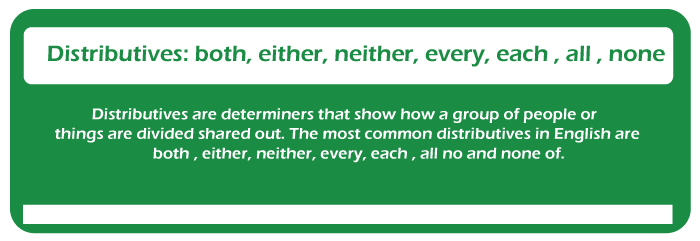Distributive DeterminersDistributive Determiner refer to the terms in a clause or statement that provide details about the nouns. They might refer to an entire group or each individual inside it. Each, every, all, both, half, either, and neither are some of the examples of Distributive Determiners. 
For example, assume you had two pens and told the listener, "Both of my pencils are black in colour." The listener understands that you are speaking about the entire group. Consider the following sentence: "Each pencil has a sparkling nib." The listener understands that you're talking about the group. Still, you're also clarifying the characteristic of individual people, in this case, ' pencils.' In the clause, each Distributive Determiner has a distinct function.
With the help of appropriate instances, we will better understand the various Distributive Determiners. Types of Distributive Determiners1. 'Each' and 'Every' are used as distributive determiners.'Each' is utilized to allude to each participant in a group, whereas 'every' refers to the group as a whole. Only countable nouns can be utilized with 'each' and 'every.' Consider the following sentences:
When accompanied by 'of,' 'each' can also be utilized for plural nouns. For Ex-
In contrast, 'every' can never be utilized with plural nouns. For example
2. The word 'all' is used as a Distributive Determiner.It can be used in a number of various ways, each with a somewhat different connotation. All can be employed as a distributive to relate to the entire group rather than individual members or objects. When referring to an idea as a whole, it is utilized with countable plurals and uncountable nouns. The term 'all' applies to the whole group of individuals. All can be employed to relate to singular countable nouns or uncountable nouns. After all, whenever you add a definite article, it refers to a specific concrete group rather than an abstract notion. You can also add 'of' with the word "each" without changing the meaning Consider the following statements as examples:
When alluding to multiple nouns, 'all' is often accompanied by 'the' or 'of the'. For example;
Uncountable nouns in the plural-

3. Use of the distributive determiner 'half'.Half denotes a precise division of a group or amount into two equal parts. Half is a distributive determiner that refers to a group of individuals or objects that has been divided in half. Individuals are not mentioned. It largely follows the same patterns as everyone else, with a few exceptions. Measurements can be referred to as half. An indefinite article in this scenario must accompany it. With the help of some instances, we will understand how to use the word 'half.'
Half is preceded with 'a' or' an' for measures. For example
4. Both, either, and neither are used as Distributive Determiners.Both, either, and neither are terms that are employed to describe a pair of people, places, or things. The term both implies to the entire pair, whereas the term either pertains to any individual member of the pair, and neither has a negative meaning and negates the pair. Both may only relate to a few items and cannot be utilized to relate to single nouns. If you want to express that this distributive is a concrete object, you might add 'of' and a definite article after it. Examine the following statements:
The statements above are all grammatically correct. Either is a distributive that conveys one of the items' positivity. As a result, it must only be employed with singular noun and pronoun. If it is accompanied by 'of,' it can also apply to plural items. Either is a term that refers to any one of the pair's members and emphasizes their equality. For example
'Neither' negates the pair and is equal to neither. The term Neither is a negative meaning distributive that refers to the entire pair of items or persons. It must be utilized with a singular noun or pronoun because it pertains to each group participant. You can make it plural if you add the word 'of' after it.
When preceded with 'of'-, either and neither can be utilized with plural nouns.
Distributives' Position in the SentenceTogether with knowing how to utilize distributives, it's critical to understand where they belong in a sentence. Remember that distributive determiners are in front of the noun phrase, usually at the start of a sentence. For instance: Both dancers were wearing sparkling clothes. - Correct Dancers both were wearing sparkling clothes. - Incorrect
Next TopicQuantifiers Determiners
|
 For Videos Join Our Youtube Channel: Join Now
For Videos Join Our Youtube Channel: Join Now
Feedback
- Send your Feedback to [email protected]
Help Others, Please Share










